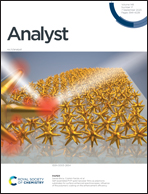Quantifying PG : VG ratio and nicotine content in commercially available e-liquids using handheld Raman spectroscopy†
Abstract
Electronic cigarettes are a popular nicotine consumption product that have risen in popularity as an alternative to cigarettes. However, their recent meteoric rise in market size and various controversies have resulted in the analyses of e-liquid ingredients to be focused on powerful laboratory-based slow methods such as chromatography and mass spectrometry. Here we present a complementary technology based on Raman spectroscopy combined with chemometrics as a fast, inexpensive, and highly portable screening tool to detect and quantify the propylene glycol : glycerol (PG : VG) ratio and nicotine content of e-cigarette liquids. Through this, the PG : VG ratio of 20 out of 23 commercial samples was quantified to within 3% of their stated value, while nicotine was successfully quantified to within 1 mg g−1 for 16 out of 23 samples without the need for accurate knowledge of flavonoid composition. High linearity was also achieved when flavours were kept constant. Finally, the limitations of Raman spectroscopy are discussed, and potential solutions are suggested.

- This article is part of the themed collection: Analyst HOT Articles 2023


 Please wait while we load your content...
Please wait while we load your content...